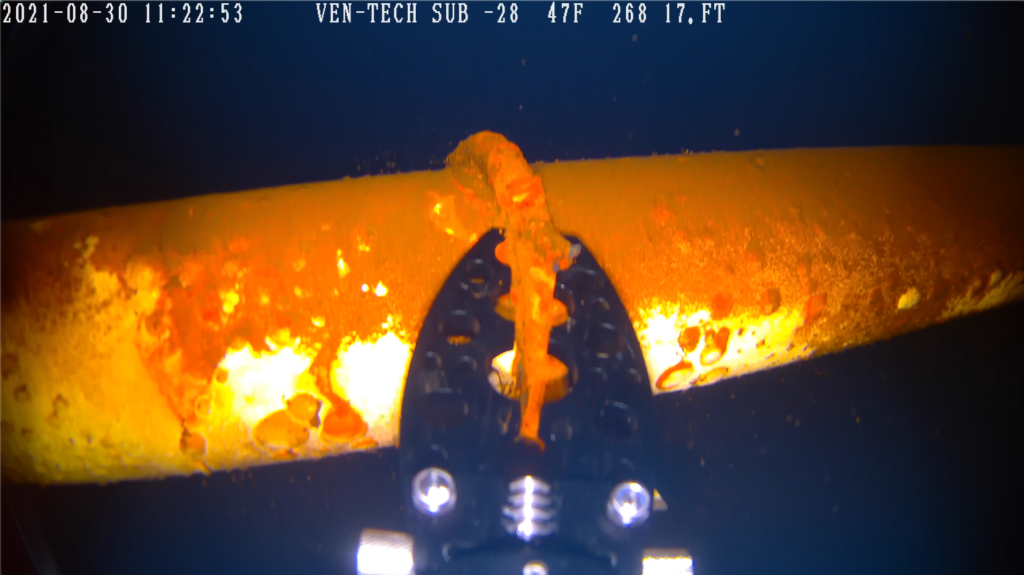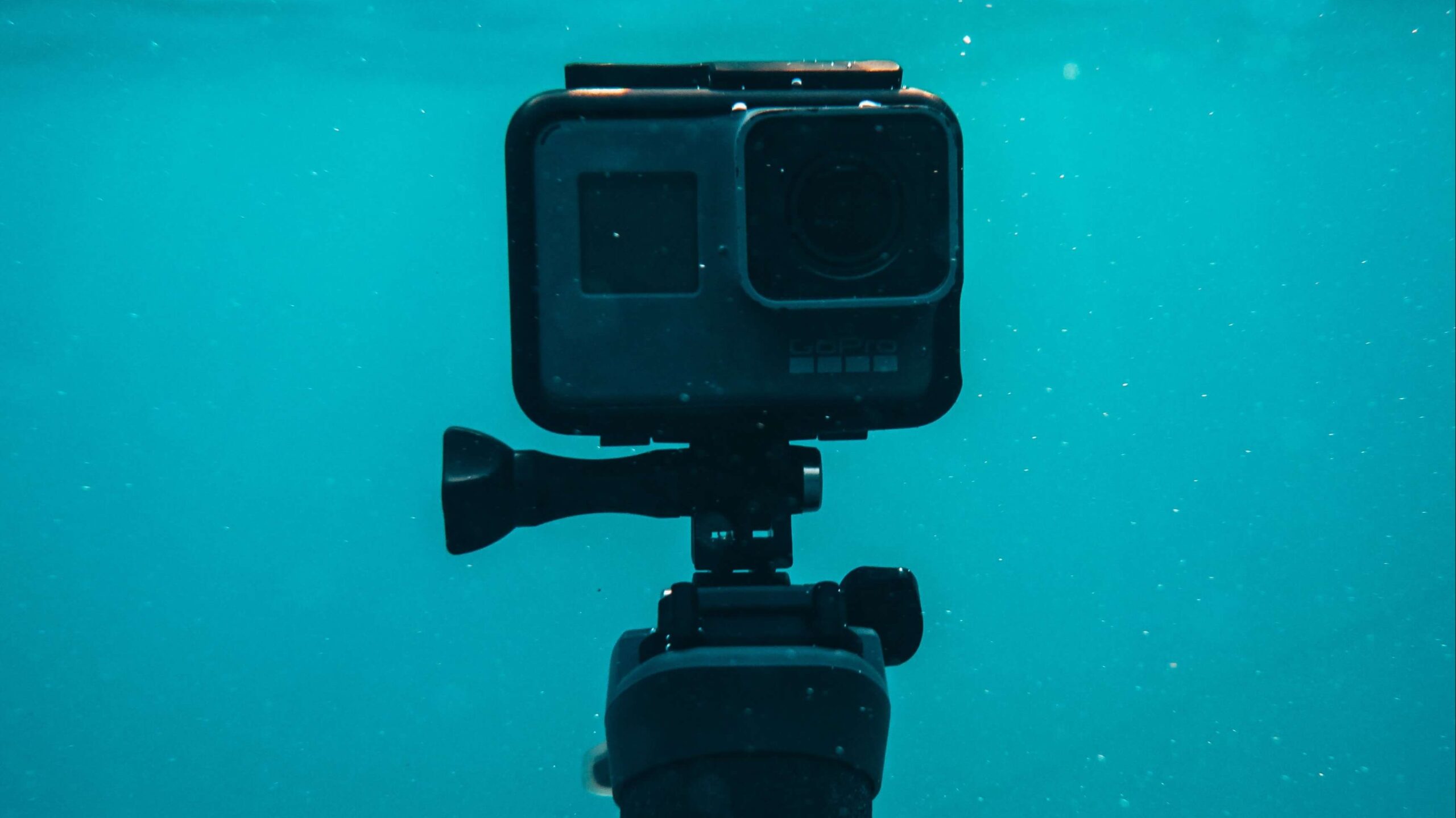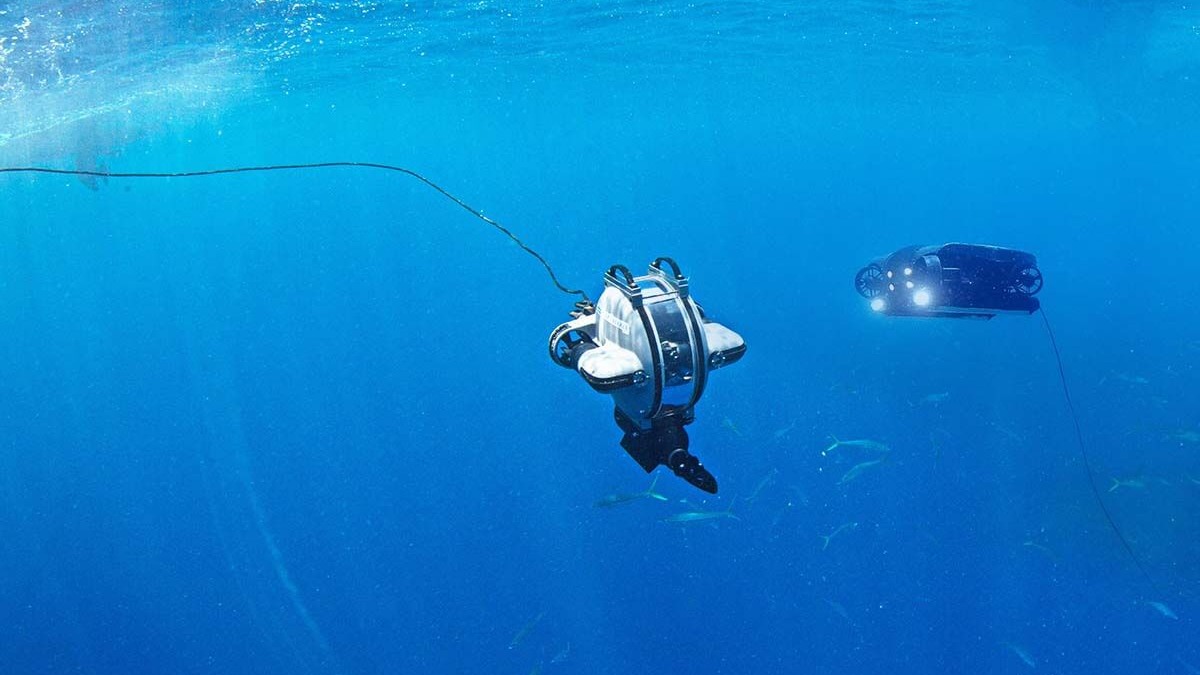Underwater photography has been around for over 150 years, with the first underwater photo being recorded in 1856! The apparatus was extremely basic, and was essentially just a metal box with one glass wall to house the camera. Since then, underwater cameras now come in a variety of styles and are capable of producing incredible high-res media. With so many options on the modern day market, this guide will lay out exactly what makes a good underwater camera.
WHAT IS AN UNDERWATER CAMERA?
In its simplest form, an underwater camera is defined by any camera that can function while completely submerged underwater. Although this broad definition is true, there are vast differences in the quality/intended use of underwater camera models.
There’s no one-size-fits-all approach to buying an underwater camera. Start by looking at the task at hand. It’s important to compare the features of each model and decide which is best suited for the project. After reading this guide, you should be able to confidently identify which model is right for you.
WHAT ARE UNDERWATER CAMERAS USED FOR?
With over 70% of the globe consisting of water, there is an obvious need for submersible cameras. Without them, we would have a complete lack of imagery for the majority of the planet and much of its wildlife!
Underwater cameras have many different applications, ranging from recreational to professional. These uses include shooting documentaries, recording sports, asset inspections, ocean exploration and research, hobby photography, etc.. With all these different applications, logically, many different styles of underwater camera systems exist to fit different needs.

TYPES OF UNDERWATER CAMERAS
In the world of modern photography/videography, there are over a dozen main types of cameras that are commonly used. However, due to the specific requirements of underwater cameras, many of these categories are impractical to use due to size constraints. Typically, there are five main styles of underwater cameras:
Action Cameras
As the name suggests, action cameras are built to be immersed in action. Their compact, durable, and handheld/mountable designs make them perfect to capture up close or POV clips during sports or events.
Being able to mount onto helmets or other equipment makes them ideal for divers or snorkelers. This design allows for the user to film while keeping their hands free to maneuver the water. As a digital camera, they easily store their captures directly on an SD card. These saved images can be uploaded to a main desktop or laptop later.
Although they are most commonly used for video recording, action cameras are also capable of taking impressive photos. This becomes especially true on higher end models. Thanks to their CMOS sensors, action cameras are capable of time-lapse, slow-motion, and burst imaging modes.
Burst imaging is a great feature for divers to get better shots of moving subjects. The camera is capturing a high number of images in rapid succession to create a “pool” of shots. After the burst is complete, you can choose from a variety of image options to get the best shot possible.
Since action cameras are built for water sports, they’re typically designed with extra layers of water resistance. This means they can be used without worrying about a waterproof housing, although a water case can extend their depth ratings.

Compact Cameras
A compact camera (aka a point-and-shoot camera) is designed with simplicity in mind. Perfect for beginners or hobby photographers, these cameras use automatic systems to set focus, aperture, ISO, and white balance. The auto settings make it incredibly easy to get a decent shot with very little effort.
Some higher end compact cameras may have manual settings and higher quality sensors. However, the main selling point of compact cameras is their affordability and simplicity, so this would come down to personal preference.
Another major selling feature of compact cameras is a single lens. This one-lens design offers less versatility for different focal lengths, but provides superb portability. A professional photographer can reap the benefits of specialty lenses for different scenarios. Whereas for the majority of hobbyists, these just add unnecessary bulk and over complicate the process.
Compact cameras don’t usually come with built in waterproofing. However, some models like the SeaLife Micro do offer a waterproof system, at the expense of image quality. For standard compact cameras, an underwater housing will have to be used.
Underwater housings are essentially waterproof and pressure resistant cases that are designed to allow full control of the camera. Compact housing bundles sell in the range of $500-1,500, roughly 5x less than their DSLR counterparts. This makes for a much more approachable price point.
DSLR Cameras
A Digital Single Lens Reflex (DSLR) camera has been the standard in professional photography for decades. DSLR’s function by utilizing a mirror inside the camera body. This mirror reflects light that comes through the lens up into the viewfinder. Pressing the shutter flips the mirror and allows light to pass through to the imaging sensor to capture a photograph.
The powerful sensors on DSLRs produce higher quality images in comparison to compact cameras. Due to the increase in sensor size, they also provide excellent low light performance. DSLRs sport optical viewfinders, which offer superior dynamic range and clarity. Additionally, optical viewfinders provide instantaneous display compared to the latency from an electronic.
The manual settings and RAW shooting capabilities make DSLRs better suited to professional photography. Rather than a simplistic point-and-shoot approach, photographers have full control over their aperture, shutter speed, and ISO. For the skilled operator, this results in higher quality shots since each image can be optimized for its setting. On top of manual settings, adjustable lenses for DSLRs also offer improved scene flexibility.
DSLRs are not typically waterproof, and will require a housing for underwater photography. The cameras themselves have an extremely wide price range, selling for anywhere between $400 and $6,000 and beyond depending on quality. Housings will generally scale in price to coincide with more advanced camera modules, usually costing between $1,000 and $4,000.
Although the top-end range of DSLRs can be significantly higher than compacts, they do provide exceptional imaging performance. Additionally, for hobbyists interested in honing their photography skills, low-cost models are a great entry point.
Mirrorless Cameras
Previously considered to be a step down from DSLR options, modern mirrorless cameras have truly made a splash among current photographers. The difference in function between mirrorless and DSLR should be fairly clear – mirrorless cameras operate without mirrors. Instead, light travels directly through the lens into the imaging sensor to be displayed via electronic viewfinder. As a result, mirrorless camera bodies are usually lighter and more compact, making them better suited for travel.
Mirrorless cameras operate very similarly to DSLRs, with high image quality, manual setting controls, adjustable lenses, and comparable price ranges. However their different mechanism design does carry some notable differences. Typically these include the use of an electronic viewfinder, quieter operation, faster shooting speeds, and better focusing. These features add up to better overall video performance compared to DSLR, which can be a major pain point for DSLRs.
Remote Vehicle Cameras
For locations which a human operator simply can’t reach, cameras built into drones or underwater ROVs are the solution. For aerial shots to add cinematic effect to videos/photos, or to survey land for construction projects, drones have become extremely popular over the past couple decades. Generally, drones use CMOS imaging sensors similar to an action camera and can range from basic $100 recreation models all the way up to $35,000 options for defense surveys/heavy retrievals.
For underwater shots, remote operated vehicles (ROVs) operate very similarly. ROVs are submersible, robotic vehicles, used to observe the depths of large bodies of water by operators from shore. These vehicles are used in a variety of industries: Aquaculture, Search and Rescue, Military, Marine Biology, Oil, Gas, Offshore Energy, Shipping, Submerged Infrastructure, Ocean Exploration and more.
ROVs can capture high definition images and videos of submerged assets far below what is capable of a human diver. Commercial diving licenses allow for open water dives of 200ft (60m). Photography at these depths would require scuba certification, protective gear, and carry the dangers of open diving. In comparison, a Deep Trekker ROV can capture 4K images and videos up to 1,000ft (305m) under the surface while the operator remains safely on shore!

ADDITIONAL CONSIDERATIONS WHEN CHOOSING AN UNDERWATER CAMERA
MP vs Sensor Size
While Megapixel count can be an effective measuring tool for image resolution, it doesn’t necessarily indicate higher camera performance. A camera sensor is made up of photosites, which are light-sensitive spots that capture digital images.
Megapixels and photosites are a 1:1,000,000 ratio, meaning a 20MP camera will house 20 million photosites. A larger sensor would also allow for these photosites to be larger. This would result in higher quality images, better depth of field, and improved low light performance. In underwater photography, where light is less abundant compared to topside, low light performance is key for optimal imaging.
Manual Shooting Controls
As mentioned in the camera style breakdowns, manual controls allow for manipulation of ISO, aperture, and shutter speed. For underwater photography, manual settings can be vital. Light is much less abundant under the water, and while modern ‘auto’ settings have respectable adaptiveness, manual control provides unmatched flexibility.
That being said, sometimes underwater cameras are used for conducting asset inspections rather than art. An automatic camera with auxiliary lighting is a much simpler and streamlined approach for clear imaging.
RAW Image Capabilities
A RAW image refers to files that have undergone minimal processing and compression. Since all the image data is stored on RAW files, the quality is excellent, but it comes at a storage cost. File size roughly translates to a 1:1 ratio to megapixels, so a 16MP camera would produce 16mb RAW images.
Photographers who want more control over post capture edits will want to opt for RAW shooting capabilities. Maintaining the full image data will provide flexibility to adjust exposure, white balance, and noise. Casual photographers who just want a quick image with some basic post-edits may be better suited to shooting in JPG.
Which Bitrate is Best?
Bitrate refers to the amount of data encoded for each second of video recording. Increasing the bitrate improves the video quality, but in turn produces larger file sizes. When purchasing an underwater camera, it’s important to gauge the intended use.
High bitrate cameras can be excellent options for professionals or content creators looking for the best quality possible. However, this may be overkill for the casual hobbyist, or someone looking to primarily take still images.
As a standard, bitrate is measured in mbps (megabits per second). Although it may seem intuitive that higher bitrate is always better, that isn’t always the case. Based on your resolution and FPS settings, below are the optimal ranges.
Recommended Video Bitrates for SDR Uploads
| Type | Video Bitrate, Standard Frame Rate (24, 25, 30) | Video Bitrate, High Frame Rate (48, 50, 60) |
|---|---|---|
| 2160p (4k) | 35-45 Mbps | 53-68 Mbps |
| 1440p (2k) | 16 Mbps | 24 Mbps |
| 1080p | 8 Mbps | 12 Mbps |
| 720p | 5 Mbps | 7.5 Mbps |
| 480p | 2.5 Mbps | 4 Mbps |
| 360p | 1 Mbps | 1.5 Mbps |
Recommended Video Bitrates for HDR Uploads
| Type | Video Bitrate, Standard Frame Rate (24, 25, 30) | Video Bitrate, High Frame Rate (48, 50, 60) |
|---|---|---|
| 2160p (4k) | 44-56 Mbps | 66-85 Mbps |
| 1440p (2k) | 20 Mbps | 30 Mbps |
| 1080p | 10 Mbps | 15 Mbps |
| 720p | 6.5 Mbps | 9.5 Mbps |
| 480p | Not supported | Not supported |
| 360p | Not supported | Not supported |
Depth Requirements
Underwater camera housings generally offer depth ratings up to 200ft (60m) to accommodate the maximum open water diving limits. While this fits a variety of recreational tasks, many industrial inspections can require imaging at much lower depths. For visuals at depths below 200ft, an ROV is an effective tool to quickly and easily capture footage.
Deep Trekker offers ROVs rated for depths of 650-1,000ft. Starting at $US 5,749, these come in at a very similar price point to a mid-range camera plus underwater housing. ROVs are operated from the surface via a handheld controller containing a 7” screen. Auxiliary and primary camera lights offer excellent visuals in dark environments, and 1080p or 4k upgradable systems provide impressive performance.
Interested in Learning More About ROVs for Underwater Photography? Get in Touch with One of our Specialists Today CONTACT INDUSTRY SPECIALIST
Dynamic Range for Underwater Photography
Dynamic range in photography refers to the ratio between the lightest and darkest color tones of an image. It is measured in stops, with the human eye capable of detecting 20 stops of dynamic range.
Depending on the intended situation, dynamic range has varying levels of importance. For shooting documentary footage, sporting events, or created high-end content, dynamic range can help deliver impressive colors and image clarity. For industrial use during asset inspections, it may not carry much benefit for inspecting neutral tone structures.
Video vs. Photo
The difference between photography and videography performance on camera options can be drastic. As mentioned above, typically action cameras will be the ideal choice for the dedicated videographer. They provide excellent video footage in a compact size, and are quite durable against the elements.
On the other hand, photographers should investigate options in either compact, mirrorless, or DSLR. These options have been the staple for still photography for years, and for good reason. Beginners may enjoy the simplicity of compact options with auto modes. Professionals would be better suited to DSLRs or mirrorless options with large sensors, manual shooting modes, and RAW file formats.

